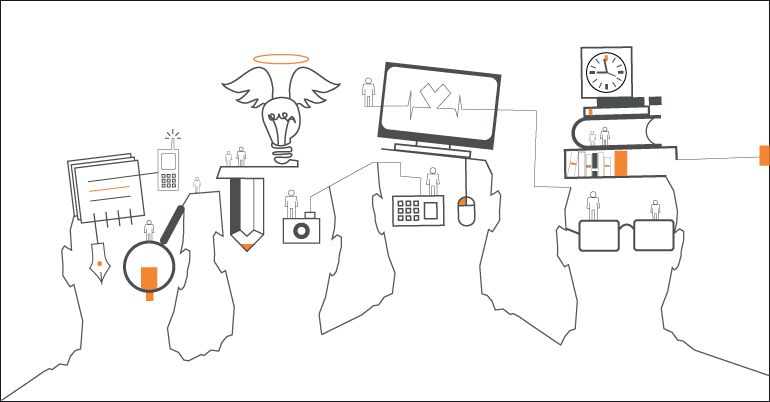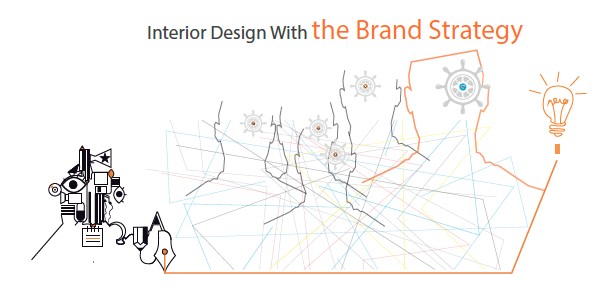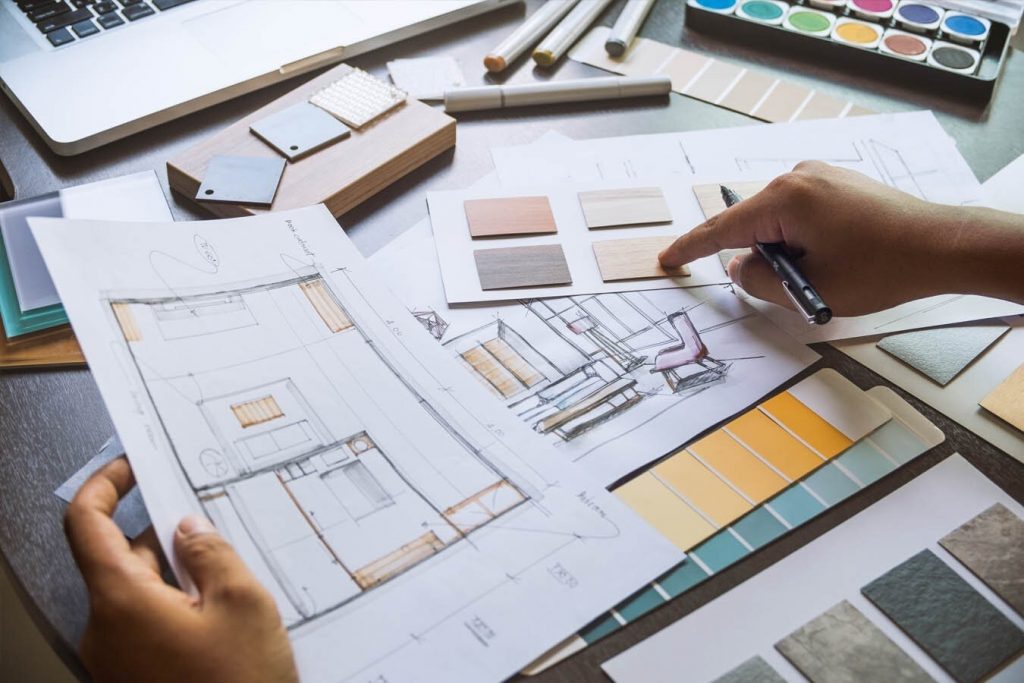Interior design with brand strategy

Good interior design should:
1. Functionality: It must meet the intended purpose efficiently.
2. Aesthetics: Visually appealing and harmonious design.
3. Sustainability: Consider environmental and resource impact.
4. Safety: Prioritize occupant well-being and security.
5. Flexibility: Accommodate changing needs over time.
6. Quality: Use durable and high-quality materials.
7. Contextual: Fit within the surrounding environment.
8. Innovation: Incorporate creative and practical solutions.
9. Client Needs: Address the client’s requirements and preferences.
10. Budget: Work within financial constraints while maintaining quality.
Balancing these elements results in effective interior design.
Transform your space into a brand experience and brand strategy that leaves a lasting impression with Absolute Creative expert interior design services. Our approach goes beyond aesthetics, prioritizing functionality, efficiency, and profitability. Our team takes a holistic approach, analyzing your target audience’s needs and defining a concept that aligns with your brand’s values and goals. We have extensive experience developing brand identities that resonate in healthcare, service firms, and other industries. Our designs are carefully crafted to enhance your brand’s reputation and appeal to your target audience. Our process is grounded in research and analysis, ensuring every aspect of your space aligns with your brand’s positioning and messaging. At Absolute Creative, we pride ourselves on creating consistent and delightful visual and experiential experiences that reflect your brand’s unique identity. Ready to take your brand to the next level? Contact us today to experience the magic of expert interior design with brand strategy. Let’s work together to create a stunning space that reflects your brand’s values and goals and leaves a lasting impression on your audience

While excellent composition design is an essential factor, it’s important to note that interior design and brand strategy are distinct entities. The priority in interior design lies in ensuring functionality, efficiency, and profitability.
ask us for quote
Architecture Interior Design | How good digital presence benefits designers
Make the Most Out of Office
The science that underpins the art of interior design is often ignored. For years, television and other media have depicted interior designers as bored, well-dressed women who believe they have a talent for matching curtains to furniture. We wanted to dispel some of the myths that have arisen as a result of this bad image by demonstrating how interior design is a vital part of providing a functional and comfortable environment for stores and companies. Absolutecreative – the marketing and branding agency – in Toronto, Canada, dedicates this article to architecture interior design.

What Is the Difference Between Design and Architecture?
When it comes to workplace renovations, you may need to engage an architect or an interior designer. These experts can assist you in creating a design that is both attractive and functional. They do a lot of the same things for your office, but they aren’t the same. Here’s how they vary, as well as some pointers on how to choose the best pro for your project.
Every structure, we feel, has a story to tell. Professionals such as interior designers and architects contribute to the uniqueness of these stories. However, when it comes to building or designing their house, many individuals are unsure who to approach. The overabundance of information on the internet has just perplexed everyone. We’re confident that at the conclusion of this article, you’ll know which expert is right for you.
Buildings are designed, reviewed, and overseen by an architect. His or her main goal is to construct a construction that is both practical, structurally sound, and visually pleasing. He or she must also possess strong analytical and problem-solving abilities.
Interior designers, on the other hand, bring their artistic skills to the table in addition to their technical expertise. The designer is hired to equip and accessorise the vacant interiors of a building after it has been completed. They do it while keeping their client’s demands, lifestyle, interests, and budget in mind. The designer is in charge of selecting materials, furniture, wall patterns, colour palettes, and decorations, among other things.
Roles of an architect
As you may have guessed, an architect should be technically proficient. However, an architect’s role encompasses a broader range of tasks. Here are a few examples:
- Examine a project’s or client’s requirements
- Create a plan/design based on the talks and make a budget proposal
- During construction, keep in mind the building codes and other laws and regulations
- Work with the construction team and contractors to ensure that the work is done in a consistent and orderly manner
- To inspect the work-in-progress, travel to/visit construction sites
Roles of an interior designer
Interior designers are also need to do some vital duties as part of their work. While having a creative bent of mind is necessary, they also have the following responsibilities:
- Meet new clients and try to sell them on their proposal
- Discuss and comprehend the clients’ requirements and way of life
- Following the talks, create a well-thought-out design strategy
- Propose to the clients a rough budget plan
- Change or alter their designs in accordance with the client’s budget or preferences
- Work with carpenters and installers to source all of the materials
- To build a living/work space, pay attention to elements such as furniture, wall design, colour scheme, design style, kitchen layouts, flooring, lighting, furnishing, and more.

What Is Interior Architecture Design?
Interior architecture design is concerned with the interior of a building and its utility for human habitation. Interior architecture combines art and science to design, restore, or update the interiors of various structures, such as houses, workplaces, and other interior spaces. Changing one type of space into another (also known as adaptive re-use) is another aspect of this style of design, such as converting the internal area of an old office building into habitable dwelling.
Who is an Interior Architect?
Interior architects are often involved in the construction or reconstruction of interior spaces, frequently altering the structure of the home. To produce a safe and habitable living environment (such as correct plumbing and electrical system setup), they must consider building construction and building codes, and they will include architectural design analysis into all of their projects. Sustainable design alternatives, such as “green” buildings with alternative heating and lighting systems, may be incorporated by interior architects.

How to Brand Your Interior Design Business
Visuals and experience are the two components of branding. Visual branding refers to your company’s overall design aesthetics. Its purpose is to provide potential clients a preview of what they can anticipate from your portfolio. It may be split down into a long number of elements in general, but in our situation, what matters is:
- Logo
- Typography
- Design files
- Invoices
- Colors
- Website design
- Marketing Materials
- Business checks
Because you work in the design business (For example), you must have excellent visual branding. Hire an expert to help you with the fundamentals (logo, fonts, and colours), and then do the rest yourself if you like. Keep in mind that consistency is essential. People frequently make the mistake of going with the style they enjoy, which does not always transfer to the brand they are trying to establish. Don’t get me wrong: those two can work together, and if they do, go for it! It’s a made-in-heaven pairing! However, no matter how beautiful the style is, it won’t work for developing your interior design business if they don’t.
The look and feel of your visual identity should correspond to the architecture interior design style you use. I’m referring to the use of colours, fonts, and images. Everything must be consistent with your work and your target customer’s aesthetics. Sweet pinks, sans serifs, and whimsical drawings can get you far if you’re targeting female clientele, but if you’re designing industrial interiors for bachelors, this technique is unlikely to earn you many gigs.
Also, make sure your graphics don’t come off as cheap if you want to attract high-end clientele. In the same way, don’t set unreasonable expectations for mid-level prospects.

Brand Identity and Architecture Interior Design
When people think of branding, they generally think of what greets the eye, but as we’ve already covered, branding is about more than just how something appears; it’s also about how it feels. Brand identity is harder to define, but not impossible to manage.
A company’s brand identity is its personality and voice. It has a soul. It’s the experience you provide your customers and the message you send to potential customers (on the blog, social media, in direct communication…). Consider your brand from the perspective of a person, and make sure you like what you see. You want your design firm to have an empowering, understanding, giving, and all-around pleasant personality.
Someone who is always willing to provide a hand and provide design solutions to people who are in need. Demonstrate what you can accomplish for them and what inspires you. With your branding, you’re not trying to outshine the competitors.
You want your branding to attract people who are in desperate need of your services. People who would only employ you, and no one else. You are THE person they are searching for, and after they get to know you and hear your message, they will realize that you are the only person who truly understands them and their vision for their future home.

Brand Your Website to Flourish in Interior Design Industry
There are several marketing methods available nowadays, but your website should be the beginning point. Before agreeing to become clients, most prospects will visit your website and assess its content. Don’t let them down!
Your website serves as a showcase of your work, demonstrating your skills and experience. It must establish trust and inspire people to contact you. Modern websites are simple and light, with a good mix of text and graphics. Every picture should adhere to your visual branding, and every content should be written by your brand identity’s pen. Also, if you haven’t done so previously, please change your old website design.
Don’t Forget Social Media
There was a time when social media platforms like Facebook and Instagram were dismissed as internet fads with no use for company promotion. The world has changed. Facebook is now competing with Google for online traffic domination.

You’ll probably be unable to keep up with everything because the advertising tools offered are so powerful. Visual material is extremely popular on social media, which is ideal for interior designers. Interior design is a perfect fit for Instagram and Pinterest. Using social media to present your gallery has the significant benefit of making all of the material sharable. You may cross-market on Facebook, Instagram, Twitter, and LinkedIn, and encourage clients and other followers to post photos with their social media networks.
New Technology for Architecture Interior Design
The majority of people associate web design with the appearance of individual pages: colour scheme, layout, images, text size, and font. Those factors are important, but what happens behind the scenes is just as important as what visitors see on the website when it comes to excellent web design.
You, as an architect, are aware of this. Although an appealing design might be nice to the eye and draw attention, it will never be adequate to compensate for poor functioning. A website, like a home or workplace, must function correctly in order to be of high value. Continue reading to find out more, or call us at 604-669-2993 if you want a perfect web design.
Digital Presence Deepens Client Engagement
Your website is your first opportunity to make a good impression. People are more likely to stay on your site, visit other pages, and contact you via email or social media if they enjoy what they see. They won’t return if they don’t like it.

In other words, the quality of your website has a direct impact on the success of your business. Visitors may discover the information they need on a well-designed website and then contact you if they want to learn more. This necessitates good content arrangement as well as simple access to communication options that allow both new and existing clients to contact your company.
Bad web design isn’t simply ugly; it’s also ineffective. A skilled web designer understands how to develop a site that not only looks good, but also loads quickly and has interactive elements that always operate. Even the most enthusiastic business prospect will be turned off by a badly designed website. Good design keeps visitors on the site longer, making them more inclined to view other sites and return.

With Absolutecreative, you will not look like amateurs
No one would entrust a multimillion-dollar project to a firm whose website appears to have been produced by amateurs. A well-designed website enhances potential clients’ trust in your company’s ability to deliver on its promises.
It’s critical to recognize the characteristics of good design and incorporate them into your website in order to build a successful, efficient website. The logic of an architect’s website should be the same as that of an architectural project. The designer creates a concept and then ensures that it can be sustained by laying a solid basis.
As previously said, website design is about more than simply the visual aspects. Remember to think about the factors that impact your site’s performance, such as:
- Functionality
- Content management
- Search engine optimization (SEO)
Your website will be the focal point of your online presence with Absolutecreative, therefore it should portray your architectural interior company in the best possible way. Our digital specialists do this by creating a website that is simple to access and manage.
Our talented designers will collaborate with you to build an appealing website design. By simplifying navigation, guaranteeing quick load times, and improving the user experience, our development team will assure constant performance. The ultimate result will be a website that is attractive, well-ranked, and draws the clients you desire.
